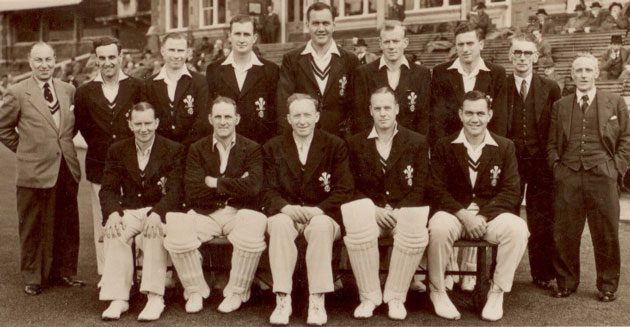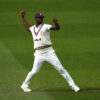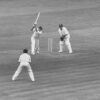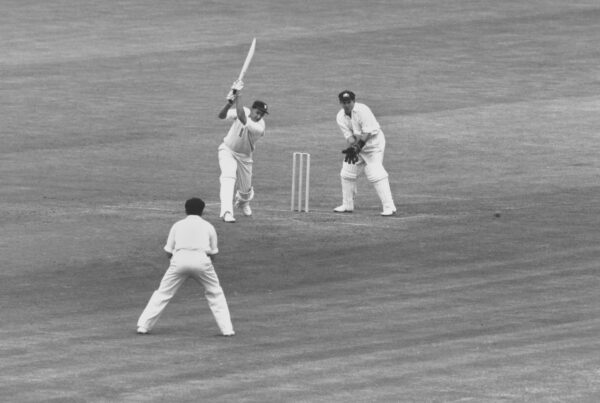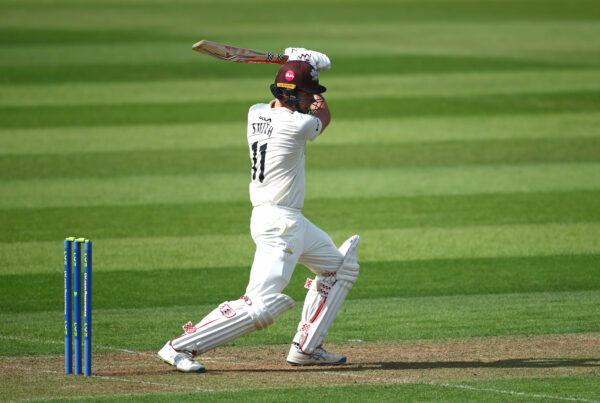It was the start of an unprecedented era of success for Surrey, who launched a run of seven successive County Championship titles. It had never been achieved before and has yet to be since.
Richard Spiller looks back 70 years.
Surrey’s season
Stuart Surridge launched what would be an unprecedented reign of success by leading Surrey to their first outright County Championship title since 1914.
It was no surprise that they should have been among the front-runners, given the county had been in the top six for the previous four seasons and shared the title with Lancashire in 1950 under Michael Barton.
But under Surridge’s buccaneering leadership they won 20 of their 28 matches to accrue 32 points ahead of runners-up Yorkshire, finishing with 256 points, the highest aggregate since the resumption of first-class cricket following the Second World War.
The following spring’s Wisden noted: “In WS Surridge, their new captain, they possessed an exuberant personality who by his own fine example in the field extracted the very best from all his men.”
As throughout the reign of Surridge – and Peter May, his successor for the last two years of the run – it was the bowlers who were key, backed up by a ring of superb catchers. Left-arm spinner Tony Lock was the leading wicket-taker with 116 wickets – also appearing in two Tests – chiefly supported by Alec Bedser (102) and Jim Laker (86), even though both played in all four Tests against India. Eric Bedser (56) and Surridge (68) also claimed a healthy share of scalps.
Wicketkeeper Arthur McIntyre’s 46 catches and 14 stumpings were backed up by Surridge snapping up 48 – establishing a county record for a fielder – Lock (37) and Parker (35) also key members of the ring, while four others reached double-figures. Off-spinner Laker noted that a team which had previously been profligate, to his immense frustration, now rarely wasted an opportunity.
But the contribution of the batsmen should not be neglected, openers David Fletcher’s (1,674) and Eric Bedser (1,541) setting the tone for Bernie Constable (1,482), Tom Clark (1,184) and Jack Parker (1,109). The latter retired at the end of the season, as did fellow stalwart Laurie Fishlock (953). Finishing top of the averages, though, was May, who cracked 804 at 67 in just eight matches, restricted first by university commitments and then Test calls.
A win by 141 runs over the Indian tourists in early May did nothing to dent the air of confidence promoted by Surridge, launching the County Championship campaign with five wins out of six, from which they rarely looked back. It wasn’t until mid-June that they were led on first innings, Glamorgan claiming the draw points at Llanelli, and the first of four defeats was only suffered a month later when Lancashire won by an innings at The Oval.
The only time anything like Surrey’s strongest side – they contributed generously to the England side throughout – were beaten was when India returned for a second match and won by six wickets, and even that was in the absence of Surridge.
The long sought-after title of outright champions, beyond their reach throughout the inter-war years, was secured with three matches to spare when Derbyshire were beaten by 212 runs at The Oval on August 22, Bedser finishing off the visitors to launch the celebrations.
A batsman’s paradise when Bosser Martin’s heavy roller had crushed the life out of pitches before the war, Bert Lock had not only repaired much of the damage done to The Oval during WW2 but now produced surfaces which were credited with offering a fairer contest.
Surrey took possession of the Championship pennant which had been inaugurated by Warwickshire the previous year.
Oval Test
England had already caused a sensation – of sorts – before the series started by appointing Len Hutton as captain, the first professional to be elevated and a move which displeased many traditionalists.
The Yorkshireman had a reasonably easy start to his spell in charge, coming up against an Indian side who were badly outclassed. By the time they reached The Oval, Vijay Hazare’s side were beaten at Headingley (seven wickets) and Lord’s (eight wickets) before being pulverised by an innings and 207 runs at Old Trafford. A clean sweep beckoned.
David Sheppard’s 119, his maiden Test century, included an opening stand of 143 with Hutton (86) and then he added 118 with Jack Ikin (53) for an England side including four Surrey players – Peter May, Jim Laker, Tony Lock and Alec Bedser – to mirror the club’s domestic strength. The progress to 326-6 was slowed mainly by left-arm spinner Vinoo Mankad, whose 48 overs included 23 maidens and yielded the wickets of May and Godfrey Evans.
A thunderstorm at lunchtime on the second day persuaded Hutton to declare and when the teams returned at 5pm a sodden pitch saw India sink to 49-5 against Fred Trueman, the new pace sensation of the summer, and Bedser. They had failed to reached three-figures in either innings at Old Trafford and another catastrophe loomed.
But rain washed out the whole of Saturday’s play and just 65 minutes were possible on Monday’s fourth day, in which time Bedser (5-41) and Trueman (5-48) finished off the tourists for 98, of which Hazare made 38.
That was it, all attempts to start on Tuesday wrecked by the weather, although the match was deemed a success financially with receipts of £19,000.
What else happened in 1952?
The United Kingdom and its still extensive empire was rocked by the death of King George VI in February, dying in his sleep at Sandringham aged 56. His eldest daughter, Elizabeth, rushed back from a tour of Kenya to be proclaimed Queen Elizabeth II.
The Korean War continued but was largely a stalemate, United Nations forces led by the USA supporting South Korea while the Soviet Union and China propped up North Korea in a conflict which had broken out in 1950 and would drag on until 1953 but has never formally been ended.
The British government – led by Winston Churchill, narrowly re-elected the previous year after six years in opposition – abolished identity cards “to set the people free”. Tea rationing also ended.
A flash flood in the Devon town of Lynmouth in mid-August killed 34 people. A train crash at Harrow and Wealdstone killed 112 passengers while at the Farnborough Airshow a plane broke up over the crowd, killing 31 spectators. The Great Smog of London, which lasted for five days in December, was held responsible for ending around 4,000 lives and sped moves to improve Britain’s air quality.
Dwight D Eisenhower, Supreme Commander of the Allied Forces Europe in the Second World War, was elected the 34th President of the United States, defeating Democrat Adlai Stevenson. He succeeded Harry Truman.
Popular children’s programmes Sooty, the glove puppet bear, and the Flowerpot Men made their debuts on BBC, TV detector vans appearing for the first time to catch those who hadn’t paid their licence fees. In the West End, Agatha Christie’s murder mystery The Mousetrap opened at the New Ambassadors Theatre. It has since moved to the adjacent St Martin’s Theatre but – lockdowns permitting – and is still running.
Matt Busby’s Manchester United claimed the Football League title while Newcastle United won the FA Cup for the fifth time, beat Arsenal 1-0 at Wembley.
Frank Sedgman took the Wimbledon men’s title, for the only time, while Australian Maureen Connolly won the women’s title and went on to defend her US Open crown.
South African Bobby Locke claimed the Open at Royal Lytham & St Annes by a stroke from Peter Thomson, the third of his four triumphs in the tournament.
Wales won the Grand Slam while Emil Zatopek was gold medallist in the marathon at the Summer Olympics in Helsinki
